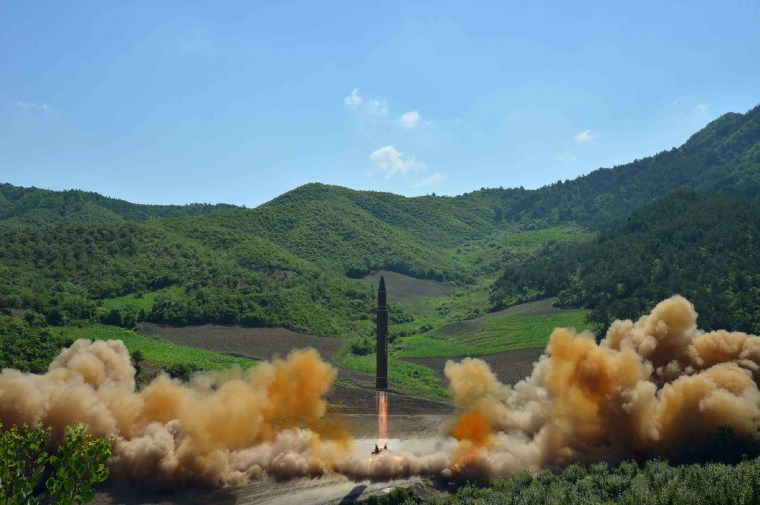WASHINGTON — The "two-stage" intercontinental ballistic missile North Korea fired this week was a weapon the U.S. had never before seen used by Pyongyang, Department of Defense officials said Wednesday.
The missile contained a re-entry vehicle and was fired from a new mobile launch site, said Navy Capt. Jeff Davis, a spokesman for the Defense Department.
Davis confirmed the missile was capable of traveling more than 3,500 miles, classifying it as an ICBM. At that range, the missile would be able to reach Alaska.
The U.S. and its allies did not shoot the missile down, however, because they did not assess it to be a threat, Davis said, adding there was still no evidence Pyongyang currently has the ability to mount a nuclear warhead to such a missile or that the missile was yet capable of full re-entry.
Nevertheless, the ICBM fired Tuesday by North Korea — the regime’s first launch of such a missile — flew through busy airspace and could have “absolutely” posed a threat to air and sea traffic, as well as satellites, because Pyongyang failed to issue any warnings or closures in advance of the launch, Davis said.
Related: North Korea Tested Intercontinental Ballistic Missile, U.S. Officials Believe
The U.S. on Tuesday condemned North Korea’s launch — a significant step forward in the rogue regime’s weapons program and an escalation of a nuclear standoff with the West — firing its own warning missiles and vowing to hold the regime accountable at the United Nations.
Earlier Tuesday, the North Korean regime had claimed it successfully fired a long-range missile into the Sea of Japan, declaring itself a "proud nuclear state."
"It is a major celebration in our history," said an announcer on North Korean state television. North Korea "is now a proud nuclear state, which possesses [an] almighty ICBM rocket that can now target anywhere in the world."
The Hwasong-14 hit its target precisely after flying for 39 minutes, state television said.
The missile landed inside Japan's maritime economic area, just outside its territorial boundary, U.S. officials said.
Related: North Korea: After ICBM Test, What Does It Really Want?
The test came days before the leaders of the world's major economies, the G-20, were due to meet and were expected to discuss ways to rein in Pyongyang's weapons program, which the North has pursued in defiance of U.N. Security Council and unilateral U.S. and South Korean sanctions.
In response, the U.S. and South Korea fired missiles into South Korea's territorial waters off the east coast, the Seoul-based Eighth U.S. Army said — moves that could be seen as a warning message to the regime.
Although North Korea is barred under a U.N. resolution from firing ballistic missiles, it routinely does so, saying its arsenal is a necessary tool to defend itself from the United States. The country has conducted five nuclear weapons tests since 2006, with two last year alone.


